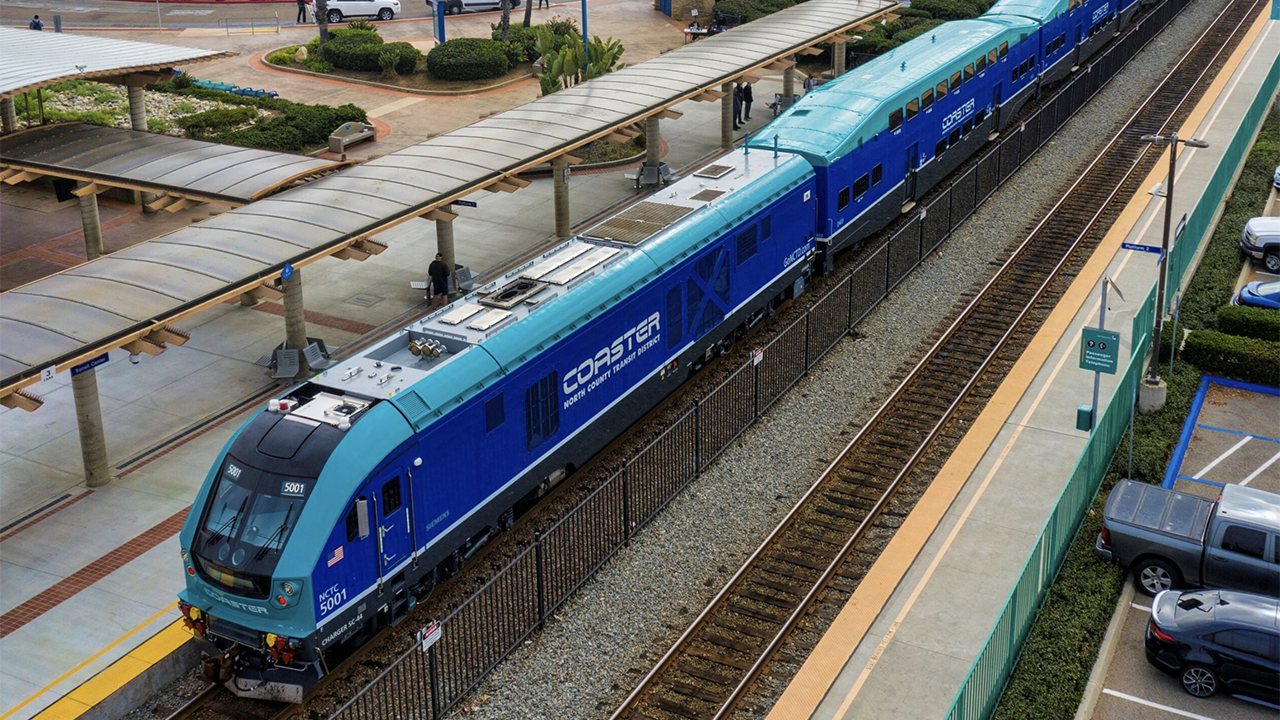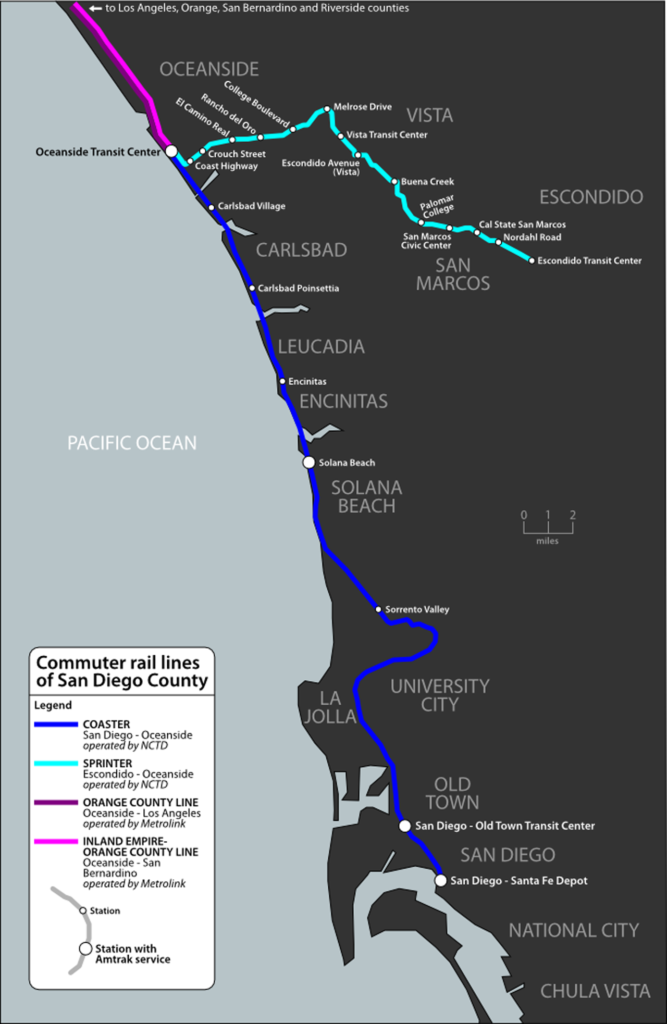
NCTD Cutting Back Coaster Fleet
Written by Marybeth Luczak, Executive Editor
(NCTD Photograph)
The Board of California’s North County Transit District (NCTD) on June 15 approved trimming the Coaster regional/commuter rail fleet by five legacy, Bombardier-built bi-levels and two just-delivered Siemens Chargers, and using the proceeds for project development and implementation of zero-emission rail technologies.
The recommendations were made by the NCTD staff at the public Board meeting.
The 41-mile, eight-station Coaster line runs from Oceanside to downtown San Diego with five locomotives and 28 bi-levels (see map below). Coaster connects with Amtrak’s Pacific Surfliner at Oceanside, Solana Beach, Old Town Transit Center, and Santa Fe Depot in San Diego; with Southern California Regional Rail Authority’s (SCRRA) Metrolink commuter rail system at Oceanside, which provides connecting service to Orange, Los Angeles, Riverside and San Bernardino counties; and with NCTD’s Sprinter hybrid rail service at Oceanside, which covers 22 miles through 15 stations between Escondido and Oceanside and includes 12 Siemens Mobility Desiro diesel multiple-unit (DMU) trainsets. It also links with San Diego Trolley and Metropolitan Transit System buses. Coaster marked 25 years of service Feb. 27, 2020.

According to the June 15 staff report obtained by Railway Age, “NCTD is seeking to optimize its rail fleet to foster cost-efficiency, advance its transition to zero emission operations, and advance planning and related activities for the procurement of a new Sprinter vehicle with capabilities to operate on the inland and coastal rail lines.” To advance this strategy, the staff “determined that it should reduce the Coaster bi-level fleet by selling five passenger bi-level coach cars that have reached the end of their useful life and sell two Siemens Charger locomotives,” which were delivered May 5, 2023.
The San Diego Association of Governments’ (SANDAG) Board in September 2019 allocated $58.8 million to NCTD for the purchase of two additional trainsets to provide more frequent—up to 42 trains per average weekday—Coaster service, offering “commuters and recreational travelers an affordable and more flexible transportation option, helping reduce congestion along the Interstate-5 corridor, and supporting regional goals to reduce vehicle miles traveled and greenhouse gas emissions,” according to the staff report. That service increase was funded by TransNet, the county-wide half-cent sales tax for transportation projects that SANDAG administers.
The first phase of increased Coaster service was approved in July 2021. Beginning Oct. 25, 2021, service went from 22 weekday daily trips (Monday through Thursday) and various weekend trips to 30 weekday daily trips, 32 Friday daily trips, and 20 weekend daily trips. The second planned phase, which would have increased frequencies from 30 to 42 weekday daily trips, has now been suspended, the staff report said. “SANDAG identified a shortfall of funding in the TransNet program related to service expansions implemented by NCTD and the San Diego Metropolitan Transit System (MTS) and the parties agreed to cap expansion of services,” according to the report. “NCTD has determined that it should optimize its current fleet to minimize operating and capital costs and begin investing in its next generation of rail technology that is assumed to be zero emissions locomotives and multiple units.”
The report explained that NCTD staff conducted an analysis regarding the current Coaster fleet and “determined that it has sufficient capacity with seven trainsets to implement further Coaster frequency improvements based on the reliability that is being achieved under the Technical Support and Material Management Services Agreement with Siemens, albeit with a higher risk factor if an accident were to occur or if the maintenance schedule was impacted due to accident damage, capital program needs, or if reliability issue(s) arise. With that said, staff does not believe that a new regional sales tax will be in place over the next five fiscal years. Accordingly, staff believes it is in the best interest of NCTD to advance the recommendations specified in this staff report.”
There is a proposed agreement to sell five bi-levels—built in 1993 and purchased using TransNet funds—to Utah Transit Authority for $1 million ($200,000 per car), according to the staff report, which recommended finalizing negotiations. The cars (Nos. 2202, 2204, 2205, 2206 and 2207), whose original price tag was $1.5 million per car, have “reached the end of their useful life” and have not been overhauled, according to a June 15 staff presentation document, which was also obtained by Railway Age.
The proceeds “can be used at NCTD’s discretion for operating or capital” projects, according to the presentation. One potential use: as “[m]atching funds for a grant to convert one Sprinter trainset to a battery-electric prototype.”
(Pending delivery are 11 bi-levels that NCTD ordered from Bombardier [now Alstom] in July 2020 for the first phase of Coaster service increases and to begin state-of-good repair replacement of legacy coaches and cab cars.)
The staff report also recommended approving the sale of two Siemens Chargers—ordered in October 2020 for $15.5 million, and recently delivered—to the California State Department of Rail and Mass Transportation or to the SCRRA. If such a sale cannot be completed, NCTD should “approve the solicitation of purchase proposals,” according to the staff report.
The report noted that the “locomotives were purchased by NCTD with non-federal funding and do not include funding from the California Air Resources Board that supported” the 2018 procurement of five Tier 4 locomotives to replace older units built between 1975 and 1992 and purchased used by NCTD. According to the staff presentation document, they were not funded to support Coaster expansion.
“NCTD will seek to fully recover all costs associated with the procurement and commissioning of the two locomotives,” according to the staff report. “Staff believes that there will be a strong market to purchase these locomotives due to inflation and the long lead time for acquiring a new locomotive.” (According to the staff presentation document, the current market price for a new diesel-electric passenger locomotive is $8 million-$10 million with a lead time for delivery of 48 months or more.)
Any profit from the sale also “can be used at NCTD’s discretion for operating or capital” projects. The staff presentation document noted that potential uses are: as “[m]atching funds for a grant to procure a zero-emissions locomotive prototype”; for “[d]esign engineering for zero-emissions related infrastructure modifications”; and as “[m]atching funds to convert a second Sprinter trainset to zero-emissions (non-SRA [State Rail Assistance] funds).”
The sales contracts, once negotiated, are subject to approval by Executive Director Matthew O. Tucker, who has led NCTD since 2008, and General Counsel Lori A. Winfree.
In a related development, NCTD in June 2022 announced that it completed insourcing its rail equipment maintenance and train operations functions, bringing “the primary functions of NCTD’s commuter rail and hybrid rail services under its direct management, including nearly 100 operations and maintenance employees.” Under the new model, NCTD, which is responsible for safety and maintenance of the entire San Diego portion of the Los Angeles–San Diego–San Luis Obispo Rail Corridor, will assume rail equipment maintenance and train operations, including personnel performing the primary functions of train operations and maintenance of equipment for its Coaster and Sprinter services, as well as preventative maintenance, minor reactive maintenance and work order requests. Prior to insourcing, Bombardier (now Alstom) had operated Coaster service and maintained rolling stock under an O&M (operations and maintenance) contract. Maintenance-of-way functions are also performed in-house.



